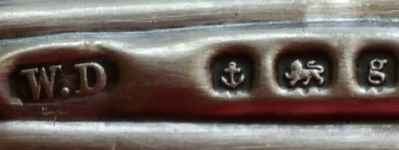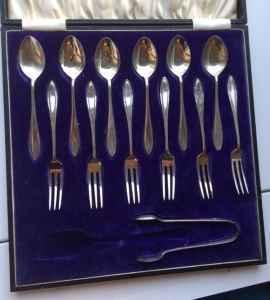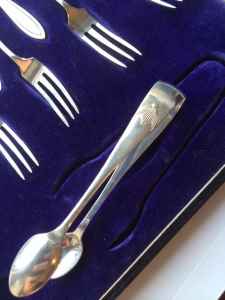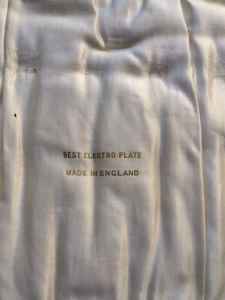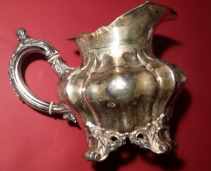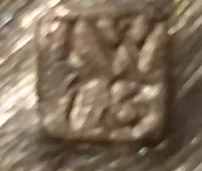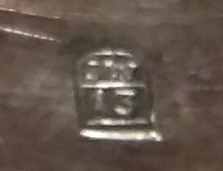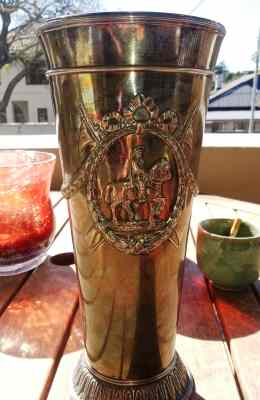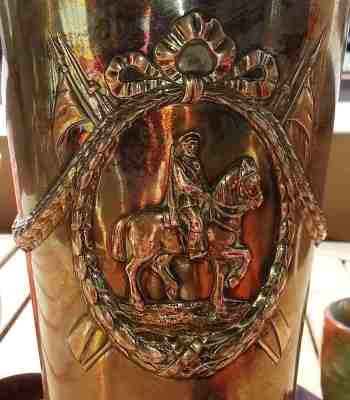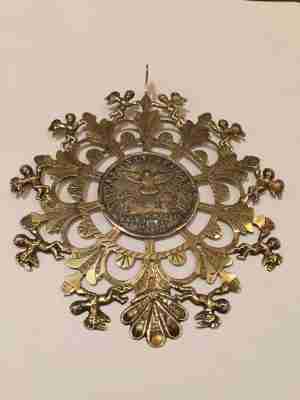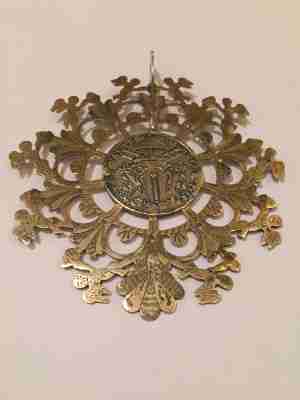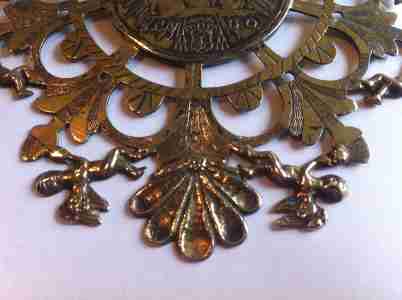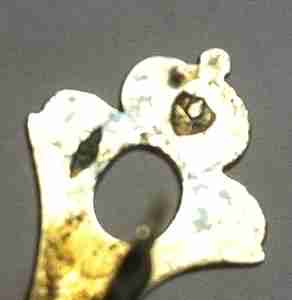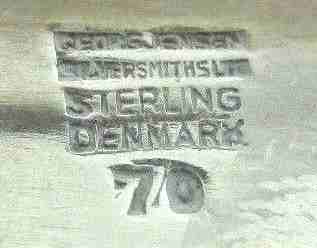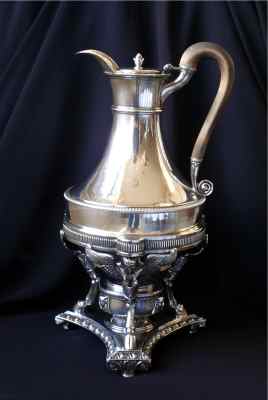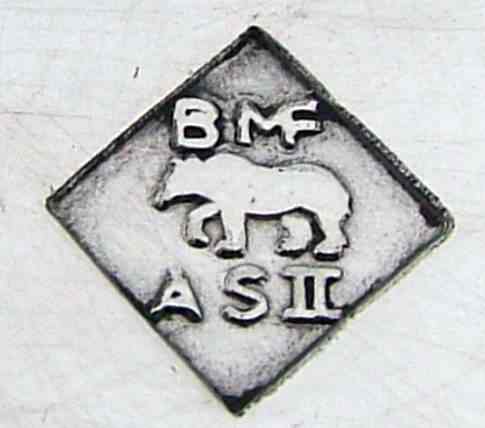
Dr. David N. Nikogosyan presents:
Marks of Berndorf Metallware Factory

The history of Berndorf Metalware Factory (shortly, BMF) is well documented [1,2,3]. I present here a few historical facts which are necessary to understand the marks used by this company.
The famous Berndorf Metalware Factory (in German Berndorfer Metallwaarenfabrik) was founded in 1843 in the small village of Berndorf, situated in the region Lower Austria (Niederösterreich) of the Austria-Hungarian Empire. Interestingly, the foundry location is connected with its marking system. Due to the assonance between the words Berndorf and Bärendorf (in German the last word means "bear village"), many of the factory marks contain a bear profile.
Though this factory got world-wide recognition under the name Berndorf Metalware Factory Arthur Krupp, before 1891 it was called Berndorf Metalware Factory Alexander Schoeller and Co. Indeed, Alexander Schoeller, the Austro-Hungarian businessman, invested a lot of money in buying the land and building the factory. The father of Arthur Krupp, Herman Krupp, joined the firm in 1844 and in 1849 took over half of the shares. When Hermann Krupp died (in 1879), 23-year old Arthur, who already worked at the factory, inherited his business. After the death of Alexander Schoeller (in 1886), Arthur Krupp paid a large sum of money to his heirs and in 1890 became the sole owner of the company. From 1891 his name appears on the mark of the Berndorf foundry.
In 1913 BMF became a public company. The World War I (1914-1918) ended with the crash of the huge Austro-Hungarian Empire. The economy of the whole Europe was in crisis. The market diminished significantly. The usual transport routes for raw materials and final products were disrupted. Nevertheless, Arthur Krupp managed to save the firm and revive the production by 1924. However in 1926/1927 and 1932 two severe economic downturns brought the closure of some BMF productions and a sharp decrease in the employees' number (from 6000 to 800)....
click here

Welcome to new ASCAS members:
Virginia Harper Breen - USA
Anne Graham - England UK
William Hugh Isbister - Germany
Alessandro Manfrin - Italy
Neville Michie - Australia
Jeannine W. writes:
...I wonder if you can give me information on this hallmark?
Thanks for your help.
Jeannine W.
Zoe Mahoney writes:
...I came upon your page when researching a spoon set I
purchased at a garage sale.
I am from Australia and was wondering if anyone was able to give
me a bit more information about the set I have.
Zoe Mahoney
The maker of your silverplate set is Charles Wilkes, 38
Camden St, Birmingham (1893-1934)
Giorgio Busetto
Christophe Ginter writes:
...Sweden 1832. Thanks to any member ASCAS for providing me with
the following information: town ? Siversmith ?
Many thanks in advance,
Christophe Ginter
Gianmarco Baldini writes:
...I recently bought this silver object, part of a set.
I believe that it is middle of 19th Century, possibly German,
but I do not manage to recognize the maker.
Please, could you help ?
Many thanks
Gianmarco Baldini
Daniel Duffin writes:
...I have as in the attached picture a Morozov imperial vase. I
was wondering if you could help me out with a little more info.
It has a military motif within one cartouche and I thought maybe
it was to commemorate some Imperial jamboree or victory?
I have had it for the last 25 years or so.
Daniel Duffin
The Russian mark isn't well readable.
Giorgio Busetto
Eric S Rijnders writes:
...A few months ago, I was able to acquire this remarkable
pendant.
In its centre is a rare Vatican silver coin, a scudo 'sede
vacante' of 1758. It figures a dove with the motto 'ubi vult
spirat' on one side and the arms of cardinal camerlengo Girolamo
Colonna on the other side. It has been struck during the vacancy
of the papal see, between May 3rd and July 6th 1758, after the
death of Pope Benedict XIV.
The coin has been mounted in a silver frame with cast cherubs.
The pendant, including the coin, has been heavily gilt.
The pendant is large (15 cms by 15 cms) and heavy. The coin
alone weighs 26.4 grams.
The only hallmarks to be found are the Vatican hallmarks of mid
18th century, which have been struck twice: once on the loop and
once on the lower front side.
It seems a bit odd for a pectoral cross but much too large for a
normal religious pendant.
I wonder if any ASCAS member could throw any light upon this
strange object.
Kind regards,
Eric S Rijnders
Marc Deconinck writes
Georg Jensen ltd seems to be a company in London importing
Georg Jensen silver.
I found this comment on the web:
"Don't be misled, though, by sellers who will sometimes
encourage you to think that the GJ Ld hallmark alone is of any
value. Like most silver retailers, the GJ shop (which remember
is effectively little more than a franchise) also sells other
non-Jensen items of silver which it 'commissions', i.e. usually
buys in bulk, which are normally stamped with the mark of the
retailer, in this case the Jensen store.
Remember, if it doesn't have a set of Georg Jensen Danish
factory marks, which usually include the relevant Jensen logo
for the period (all well documented on the internet), the words
'Sterling' and 'Denmark' and a design number, then it isn't
Georg Jensen.
There are a very small number of exceptions, but most of them
will be present in one form or another.
My comment: I believe your item has not the Georg Jensen Danish
factory marks, so should it be no Georg Jensen?
Marc Deconinck
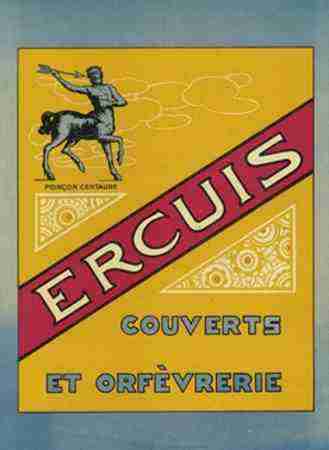 |
This month ASCAS presents an ancient advertisement
of:
ORFEVRERIE D'ERCUIS
The firm was founded in 1867 by Adrien Céleste
Pillon, on the small village of Ercuis, 50 km north
of Paris (France).
Since 1880 the firm was active with a sale room and
commercial offices in Paris.
In 1908 the firm became "La Société nouvelle de l'Orfèvrerie
d'Ercuis" under the management of Georges Maës.
Maës family continued to manage the firm until the
1980s, when the Rouget family took over the control
of the company. In the same years the firm bought
Ravinet d'Enfert, another great French silver
manufacturer.
The "Centaur" is the trade mark of the company.
This image is part of the
ADVERTISEMENTS IN SILVER - SILVER ADVERTISING
section of www.silvercollection.it website
|
"A WORD per MONTH"
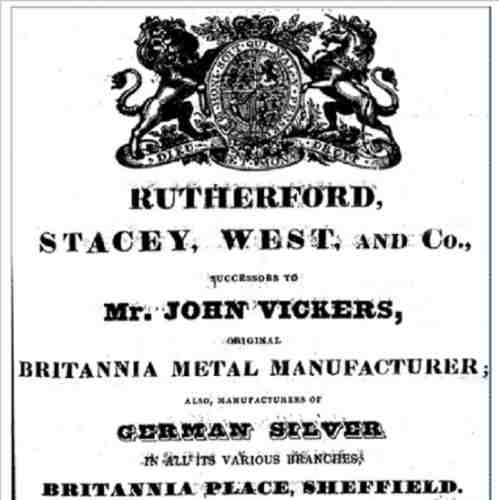
|
BRITANNIA METAL
Pewter is known to have been used in Britain since
the Roman occupation. Little is known about its use
until the Middle Ages when pewter began to appear on the
church altar and on the table of the nobility.
With the progression of years pewter became available
for others social classes, gradually replacing their
wooden eating and drinking vessels.
In 18th century the use of silver continued to be
restricted to the nobles and the desire of the working
class for better things created a new market which was
satisfied by two closely related Sheffield industries:
the making of Sheffield Plate and Britannia wares.
The method of plating silver on copper (now known as Old
Sheffield Plate) was discovered in 1743 by Thomas
Boulsover and by 1750 the Sheffield Plate industry grew
and flourished for one hundred years.
The middle class also looked for a product which would
add a touch of elegance to their home life. This
economic market was one factor which prepared the way
for the Britannia metal industry. Unfortunately the long
established pewterers were unable to supply the need for
elaborate tea services and tableware at modest cost.
The pewter industry had been reduces to the limited
production of plates, tankards and measures as the
concept of pewter making had always been exclusively one
of casting and the investment in very expensive new
moulds for new products was too speculative for a
declining industry.....
more
|
"A SILVERSMITH per MONTH"
|
|
PAUL STORR
Paul Storr (1771 - 1844) was
apprenticed to Andrew Fogelberg, a Swedish silversmith
active as "plateworker" at 30 Church Street, Soho,
obtaining his freedom in in 1792. In the same year Storr
entered in partnership with William Frisbee registering
their joint mark "WF over PS" (the address was 5 Cock
Lane, Snowhill). The partnership was of short endurance
and Storr entered his own mark "PS" on 12th January 1793
(the address was 30 Church Street, Soho). The "PS" mark,
with few modifications, was maintained by Storr until
his retirement in 1838.
In 1796 Storr installed his business in 20 Aire (Air)
Street, St. James', Piccadilly, where he remained eleven
years. It was here that Storr made a name for himself as
one of London's leading manufacturing silversmiths. Here
Storr received orders from the great noble houses of
England for cups, vases, kettles, wine coolers, dishes
and plates.
Whether such orders were commissioned through Philip
Rundell is not proved, but it is certain that at this
time he was very anxious to get Storr to work for him
exclusively. Rundell persuaded Storr to leave Air Street
and move to larger premises at 53 Dean Street. Soho. But
before he agreed to move Storr made clear that by so
doing he had no intention of losing his identity. He
would call the new business "Storr & Co", continue his
own work at the new address and execute any orders which
Rundell might give him. Matters were satisfactorily
settled and the move was made in 1807.....
more
|
"A CREST per MONTH"
SIMPSON
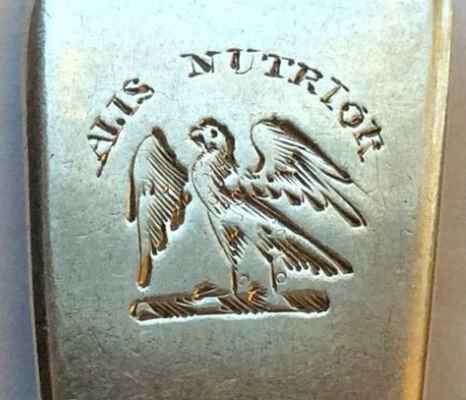
|
The crest of Simpson family (Sco.
and Lond.)
A falcon, volant
The Latin motto is "Alis nutrior" (I am fed by birds)
The crest was found in a spoon marked Edinburgh 1830,
makers James Howden & Co and A. Edmondson
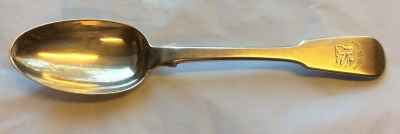

|
Closing our FEBRUARY 2015 edition of ASCAS Newsletter I hope
you have appreciated its content.
Your comments, suggestions and advice will be of great help.
My thanks to Gianmarco Baldini, Marc Deconinck, Daniel Duffin,
Christophe Ginter, Jeannine W., Zoe Mahoney, Dr. David N.
Nikogosyan and Eric S Rijnders for their precious contributions.
Giorgio Busetto
Secretary
DISCLAIMER AND PRIVACY POLICY
ASCAS is a community of people having a common
interest in antique silver.
It is a non-profit association without commercial links.
Membership is open to whomever has a true interest in
this subject matter.
ASCAS has no real property and no fees are requested nor
accepted from members.
ASCAS keeps in touch with its members only through
periodical newsletters, e-mails and web-site updating
and ignores and is not responsible for any other
activity pursued by its members.
Likewise, ASCAS is not responsible for opinions,
evaluation and images displayed, and in any form
published or supplied for publication, by its members
who, in any case, maintain the property of their works
and assure the respect of national and international
legislation about Intellectual Property.
ASCAS does not have the full addresses of its members (only
town, country and e-mail address are requested for
membership).
ASCAS handles and protects with care its members' e-mail
addresses, will not disclose the addresses to third
parties, will use this information only to reply to
requests received from members and for communications
strictly related to its activity.
These rules are expressly accepted by submitting the
membership request.
|
|
 newsletter
# 129 February 2015
newsletter
# 129 February 2015









